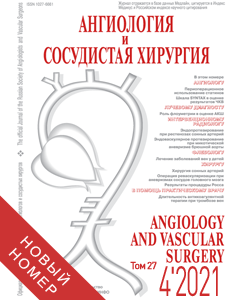Journal «Angiology and Vascular Surgery» •
2013 • VOLUME 19 • №3
Effect of the form of pathological tortuosity of the internal carotid artery on cerebral haemodynamics
Kaplan M.L., Bontsevich D.N.
Chair of Surgical Diseases No3 with the Course of Cardiovascular Surgery, Gomel State Medical University, Gomel, Republic of Belarus
The prevalence of pathological tortuosity of carotid arteries according to the findings of angiographic studies varies from 10% to 43%. This pathology is morphologically diversified, requiring detailed verification of its forms in order to specify the character of impaired cerebral haemodynamics in each individual case.
All patients presenting with manifestations of cerebral insufficiency underwent ultrasonographic duplex scanning of the vessels of the system of the brachiocephalic arteries according to the standard methods, measuring the volumetric velocity of blood flow before and after the pathological bend, the blood-flow linear velocity gradient. Revealing haemodynamically significant alterations was followed by contrast-enhanced computed tomography with subsequent 3-D reconstruction based on which we selected an optimal projection making it possible to measure the angles of the pathological bends.
The second stage of the study consisted in mathematical calculations of the haemodynamic indices (the Reinolds number allowing of determining the regimen of the blood flow along the vessels, local losses of head according to the Weisbach formula, loss of pressure for local resistance), and statistical treatment of the data (two-tailed exact Fisher’s test, Statistica 6.0).
The obtained findings suggest a statistically significant increase in the prevalence of ischaemic stroke in patients with the angle of the pathological bend measuring 60º and less. Patients of this group are found to have an increase in the linear velocity of blood flow exceeding 150 cm/s and the value of the gradient over 2.4, thus suggesting haemodynamic significance.
An increase in the acuity of the angle of a smooth turn from 60º to 30º was accompanied by a 3-fold increase in loss of pressure on the portion of local resistance from 509 to 1,466 Pa. Thus, in the vessels with the angle of a smooth turn of 90º and more haemodynamic alterations to a large extent depend on the internal surface of the vascular wall, in the bends of the vessel with a turning angle of less than 90º they depend on the value of the angle of a smooth turn.
KEY WORDS: pathological tortuosity, kinking, coiling, ischaemic stroke, cerebral haemodynamics.
P. 106
ARCHIVES MAGAZINE
2021 (Vol.27)
2020 (Vol.26)
2019 (Vol.25)
2018 (Vol.24)
2017 (Vol.23)
2016 (Vol.22)
2015 (Vol.21)
2014 (Vol.20)
2013 (Vol.19)
2012 (Vol.18)
2011 (Vol.17)
2010 (Vol.16)
2009 (Vol.15)
2008 (Vol.14)
2007 (Vol.13)
2006 (Vol.12)
2005 (Vol.11)
2004 (Vol.10)
2001 (Vol.7)
2000 (Vol.6)
1999 (Vol.5)
1998 (Vol.4)
1997 (Vol.3)


